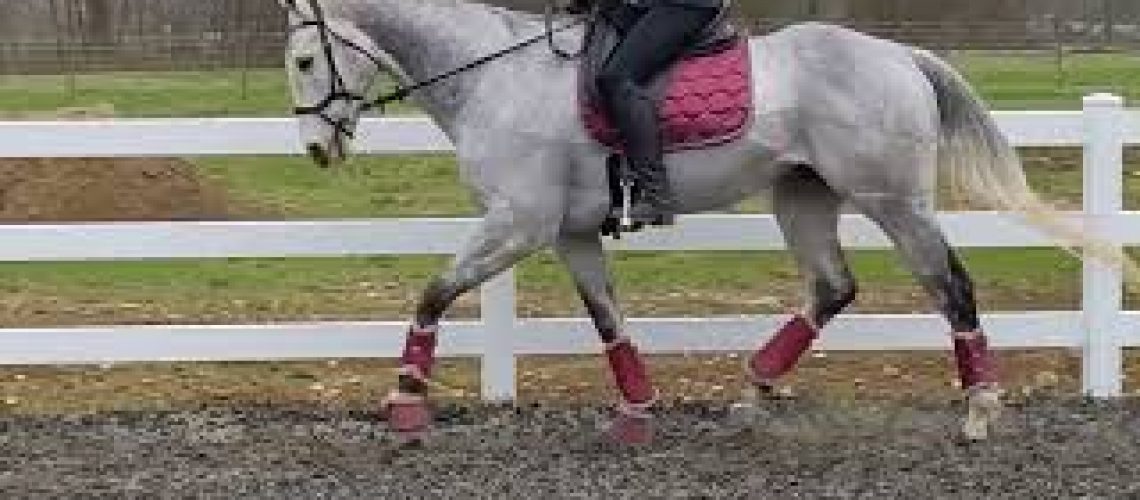According to the dictionary, contact means “the state or condition of physical touching” and “the state or condition of communicating or meeting.”
In my mind, only if we take both of these definitions together can we really get a sense of the concept of “contact” as it relates to riding and training a horse.
The third step in the German Training Scale is “Connection.” Connection means connecting the horse’s rear to its front through energetic impulses that run through its body. This connection cannot occur without the rider’s hands having physical contact with the horse’s mouth through the reins attached to the bit, held in the horse’s mouth by the bridle. This contact is both a means of physically touching the horse and communicating with him.
Contact is a living, breathing thing, as the horse and rider are both in movement, and as muscles and joints flex and move, the contact changes from moment to moment. We may hear the words “steady contact” and “quiet contact” and get the impression that contact is somehow unmoving or rigid, but those terms are defined within the dynamic nature of the horse’s movement.
Since our arms are too short to actually reach the horse’s mouth while we are sitting on their backs, the contact through the reins gives a rider the ability to physically communicate with the horse’s head, neck, and shoulders. There are as many ways of touching the horse’s mouth through the reins as there are words for snow in Alaska. But all of these rely on one underlying principle, which is that riders *must* be secure enough in their balance on the horse to be able use their hands independently of the rest of their bodies. We are, after all, touching the horse’s mouth with a metal bit. We owe it to the horse to be able to do so with at least some degree of finesse. That takes time, so if you aren’t quite there in your riding, be patient and give yourself the time to become more stable and balanced before worrying about contact. Both you and your horse will likely benefit greatly from riding your horse with some well adjusted side reins to help steady his balance while you develop your own.
Let’s assume that you are reasonably independent in your balance, and you really want to figure out this concept of contact. What should it look like? What should it feel like? How can you know when it’s right? And how can you fix it if it’s not? Well, read on, dear reader!
At the very beginning of its career as a riding horse, the young horse must learn to *accept* contact. That means, when it feels contact with its mouth, it doesn’t fight, throw its head, gape its mouth, stop and run backwards, or otherwise have a tantrum because it feels your hands in contact with its mouth. This is *not* connection. This is simply acceptance of the physical contact from the rider’s hands. At this point the horse must learn that sometimes the contact means “slow down,” sometimes it means “turn,” and sometimes it means “stop.”
As the horse becomes stronger, more balanced, and accepts the direction of the contact, then it can begin to turn into connection. At this point we want the horse to start learning to “seek” the contact. This is where thousands upon thousands of riders fall into a deep, dark pit and never quite manage to get out of it. That deep, dark pit is called teaching the horse to *give* to the contact instead of seeking it.
Now, let me take a step back and clarify that statement. If we have educated the horse’s mouth properly, he should have learned that contact with the bit is meant to encourage him to soften his jaw, maybe chew on the bit a little, and relax his mouth. These things can be taught to the horse without a rider on his back, but must translate to the feeling of the bit in his mouth with a rider. The reason this must be his response to the bit is because only when he keeps his jaw soft and mobile in response to the contact can he relax his neck and back, and swing his hind legs freely forward. Teaching the horse this response to the bit tends to give the rider the feeling that the horse is having a “conversation” with the rider’s hands. It gives the rider the feeling that the contact is “alive” and dynamic, not rigid or dead.
I make a distinction between this response to the bit vs. the concept of the horse “giving” to the bit for a very important reason. If the horse learns to “give” to the bit instead of “relaxing” to the bit, he will never try to make a connection with the rider’s hand through the bit. Instead, he will hide just behind the contact, curl his neck over instead of pushing it out, and connection through his body is impossible because he won’t truly be “in” the rider’s hands. This contact will never be steady, and will encourage the rider to ride “backwards” with her hands instead of riding forward into the contact. It seems like such a subtle difference, but it makes all the difference in the world when you are trying to develop the horse into a strong and supple athlete.
Once a horse has been taught to “give” to the bit, it is very tricky and difficult to retrain it to “seek” the bit. This is the most common failure point when it comes to training horses to accept contact, however, so it is worth taking whatever time it takes to make sure you get this right before trying to move on.
If, however, the horse takes up a conversation with the bit when he feels the rider’s hands, and then the rider closes his/her leg and sends more energy from the horse’s hindquarters forward, the horse will naturally seek to stretch its neck forward and out to whatever degree the length of reins, and his own strength, allows for. Let me say that again; the energy generated in the horse’s hindquarters by the rider’s *legs*, result in the horse seeking the contact forward into the rider’s hands. Connection begins with active hind legs.
Now, there are two things I want to make a special point to highlight here. First, the horse may try every other option to stretching its neck out, no matter how well you’ve educated him on what to do with his mouth in response to the contact. This is not a scientific formula that you add the right ingredients in the right measures and you get the same result each and every time. Training horses is much more art than science, and this is why the rider must have a very clear idea of what he/she is trying to achieve with the horse, or there will just be a confusing mess. But, given the right amount of forward impetus, and a sufficiently steady “contact” with the horse’s mouth, the result will eventually be that the horse learns to push through its body and stretch through its neck to seek contact with the rider’s hand, with a soft, relaxed jaw.
The second point I wish to highlight is that the horse’s *strength* dictates how far it can stretch its neck out in response to the forward aids. I see many, many riders expect the horse to be able to lengthen its neck to a much greater degree than it physically can at its current state of physical development. Sometimes the horse can only maintain this “seeking” posture with a fairly short rein, and would completely lose it if the rein got longer. Or, it can only move in that seeking posture for a few strides at a time before losing balance and having to be assisted to rebalance and try again. This will be the case whether you are asking the horse to seek the hand up and out, or down and out; strength will always be the limiting factor in holding that connection.
One other thing I will make note of here is that if you give your hands forward the moment the horse seeks the contact, you will interrupt the connection and teach the horse the exact opposite of connection. I think of that a bit like calling someone up and then hanging up on them the moment they answer. It’s counterproductive to encouraging conversation, and it’s frankly rude. I know many riders who think they are rewarding the horse by giving the contact like that, but that is actually a better way to teach the horse to not trust the rider’s hands than to reward him.
However strong the horse is, or however long it can maintain this seeking posture, the result is a feeling that the horse’s mouth, neck, and body are very elastic. Like the reins are bungee cords that you’re holding onto, and that if you firm up your body for a moment without changing the feel in your hands, the horse will compress himself between your legs and your hands and shift his weight slightly to his hind legs, becoming better balanced. This makes the rider feel as though you could ask the horse to do anything, and you’d get it.
This is connection, and what properly utilizing the contact with the horse’s mouth can create. Go forth and connect with your horse!

